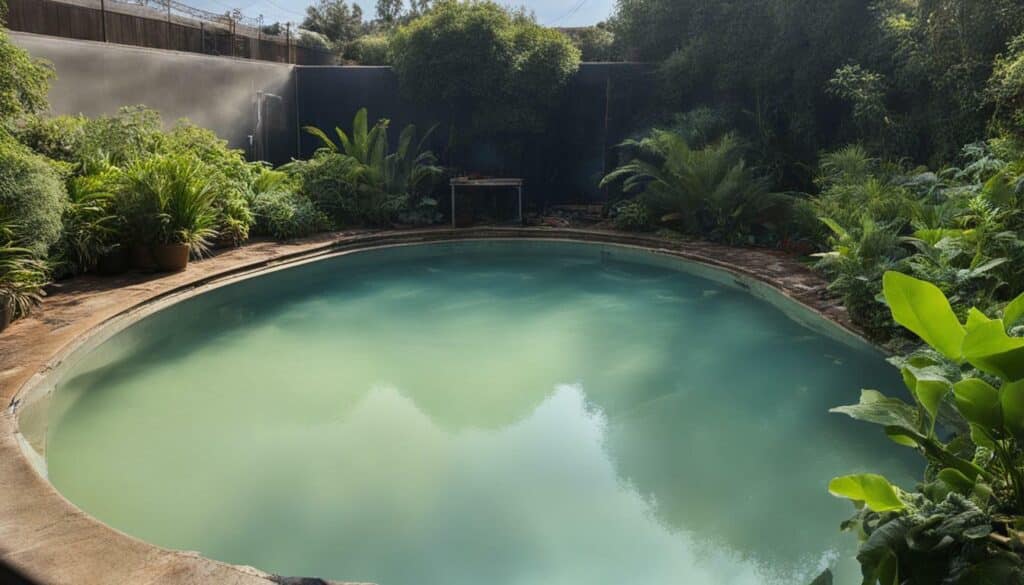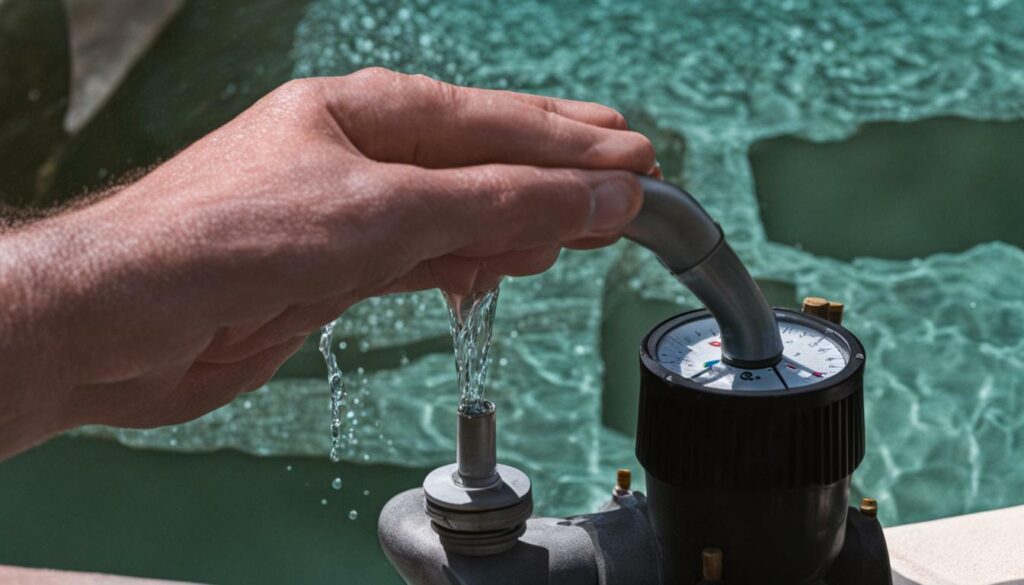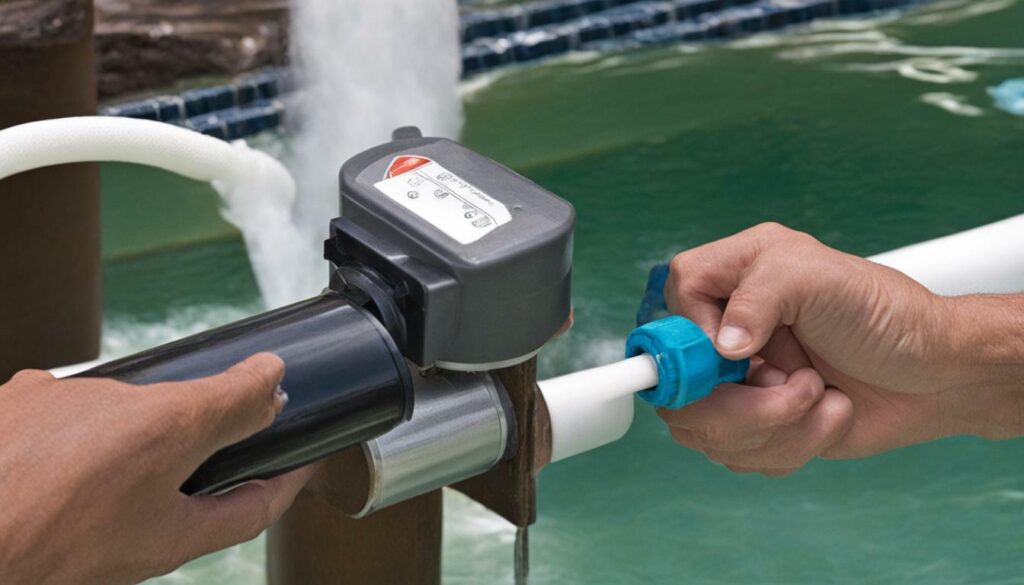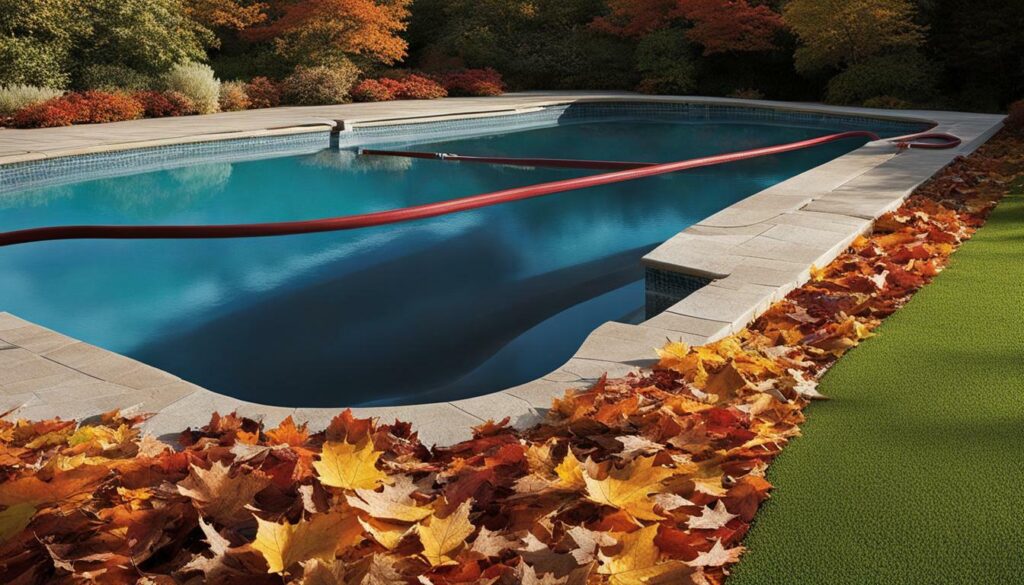Draining a pool is a necessary process for repairs, resurfacing, or balancing chemicals, and understanding the time it takes can be helpful for planning and maintenance.
- The time it takes to drain a pool depends on various factors such as pump speed and pool size.
- Following local laws and regulations is crucial when draining a pool, including having a disposal plan for the water.
- The two common methods for draining a pool are using a hose and sump pump or a pool’s drain adapter.
- After draining, it is essential to clean the pool thoroughly and conduct water tests before refilling.
- Maintaining proper chemical balance in the pool water is crucial for ensuring optimal conditions.
Draining your pool efficiently and effectively is crucial for proper maintenance and necessary repairs. By understanding the factors that affect pool drainage time and following the correct procedures, you can complete the process smoothly. In the following sections, we will discuss the different methods, legal considerations, and necessary steps to take when draining a pool. Additionally, we will provide expert tips for maintenance and highlight the importance of regular upkeep for the longevity and performance of your pool.
Factors Affecting Pool Drainage Time
The time it takes to drain a pool can vary depending on several factors that impact the pool draining process. Understanding these factors can help you estimate the average time it will take to drain your pool in a given situation.
One of the main factors is the size of the pool. Larger pools naturally take longer to drain compared to smaller ones. The pump speed also plays a crucial role. A more powerful pump will be able to remove water at a faster rate, reducing the overall drainage time.
Another factor to consider is the condition of the pool. If the pool has a lot of debris or dirt, it may clog the drainage system and slow down the process. In such cases, it’s recommended to clean the pool before draining to ensure a smooth and efficient process.
Additionally, the type of drainage method used can impact the time it takes to empty a pool. Draining a pool using a hose and sump pump is a common method that many pool owners use. On the other hand, using a drain adapter specifically designed for pool drainage can be more efficient and faster.
| Factors Affecting Pool Drainage Time | Average Time to Drain a Pool |
|---|---|
| Pool Size | Varies depending on size |
| Pump Speed | Faster pump speed reduces drainage time |
| Condition of the Pool | Debris or dirt can slow down the process |
| Drainage Method | Varies depending on the method used |
It’s important to note that draining a pool should only be done when necessary, such as for repairs, resurfacing, or balancing chemicals. Furthermore, it is crucial to follow local laws and regulations regarding pool drainage and have a proper disposal plan for the water.
- The time it takes to drain a pool can vary depending on factors such as the pool size, pump speed, and condition of the pool.
- Cleaning the pool before draining can ensure a smooth and efficient process.
- Using a drain adapter specifically designed for pool drainage can expedite the process.
- It is important to follow local laws and regulations and have a disposal plan for the water.
Draining a Pool Using a Hose and Sump Pump
One common method of draining a pool is using a hose and sump pump, which can affect the duration of the pool water drainage. This method involves connecting a hose to the pool’s drainage port and using a sump pump to pump out the water.
The time it takes to drain a pool using a hose and sump pump depends on several factors. First, the speed of the sump pump plays a crucial role in determining the drainage duration. Higher-powered pumps can remove water more quickly, reducing the overall time required.
Additionally, the size of the pool also impacts the drainage time. Larger pools naturally contain more water, so draining them will take longer compared to smaller pools. It is important to consider these factors and allocate sufficient time for the process.
| Pump Speed | Pool Size | Drainage Duration |
|---|---|---|
| Slow | Small | 4-6 hours |
| Medium | Medium | 6-8 hours |
| Fast | Large | 8-10 hours |
It is important to note that these durations are estimates and can vary based on individual circumstances. Factors such as the efficiency of the pump and the presence of any obstructions in the drain can impact the overall drainage time.
Once the pool is drained, it is crucial to proceed with cleaning and maintenance to ensure its longevity. Proper cleaning techniques and regular maintenance will help keep the pool in optimal condition, ensuring a safe and enjoyable swimming experience.
Draining a Pool Through a Drain Adapter
Another method for draining a pool is through a drain adapter, which may have a different time frame for complete water removal. This process involves connecting a hose to the pool’s drain adapter and directing the water to a suitable drainage area. The advantage of using a drain adapter is the ability to control the flow rate of the water, resulting in a more efficient and precise draining process.
The time it takes to drain a pool through a drain adapter can vary depending on several factors. The size of the pool and the power of the pump used will play a significant role in determining the duration. Generally, larger pools with more water will require more time for complete drainage, while smaller pools can be emptied relatively quickly.
It is important to note that the time frame for pool water removal through a drain adapter can also be influenced by the condition of the pool and the cleanliness of the drainage system. Regular maintenance and cleaning of the drain adapter can help optimize its performance and facilitate a faster draining process.
Legal Considerations and Disposal Plans
Before draining a pool, it is crucial to familiarize yourself with local laws and regulations regarding pool water disposal. These laws vary from region to region and are in place to protect the environment and prevent contamination of water sources. Failure to comply with these regulations can result in fines or legal consequences.
One important consideration is to have a proper disposal plan for the water. The water removed from the pool can contain chemicals and contaminants that are harmful if released into the environment. It is essential to ensure that the water is disposed of in a responsible and environmentally-friendly manner.
To determine the appropriate disposal method, you can contact your local authorities or environmental agencies for guidance. They can provide information on approved disposal sites or offer advice on how to treat the water before releasing it. Some regions may require the water to be treated or professionally handled by licensed companies.
| Disposal Options: | Pros: | Cons: |
|---|---|---|
| Treatment and Recycling | – Environmentally-friendly – May be cost-effective in some areas |
– Requires additional equipment – May not be available in all areas |
| Reuse for Irrigation | – Can conserve water resources – May be suitable for certain landscapes |
– Limited to areas with irrigation needs – May require additional permits |
| Authorized Disposal Site | – Ensures proper handling and treatment – Complies with local regulations |
– Additional fees may apply – May require transportation |
It is important to note that it is not recommended to drain pool water directly into storm drains, as these are connected to local water sources and can lead to pollution. Always follow the guidelines provided by your local authorities and take the necessary precautions to protect the environment.
“Proper disposal of pool water is not just a legal requirement, but an ethical responsibility to protect our environment.” – Environmental Agency
Cleaning the Pool after Draining
After the pool has been drained, proper cleaning techniques should be employed to ensure it is ready for refilling or maintenance. The first step in the cleaning process is to remove any debris or leaves that may have accumulated at the bottom of the pool. This can be done using a pool net or a vacuum cleaner specifically designed for pool cleaning.
Once the debris has been cleared, it is time to scrub the pool walls and floor to remove any dirt, algae, or stains. A pool brush with nylon bristles is recommended for this task, as it is gentle enough not to damage the pool surface. Begin at one end of the pool and work your way towards the other end, applying firm but gentle pressure.
For more stubborn stains or algae growth, a pool cleaner specifically formulated for these purposes can be used. Follow the instructions provided by the manufacturer carefully and ensure that the pool is thoroughly rinsed after using any cleaning products.
Finally, it is important to clean the pool filter to ensure optimal performance. Remove the filter cartridge or backwash the sand or diatomaceous earth filter according to the manufacturer’s instructions. Clean the filter using a hose to remove any debris, and replace or reinstall the filter cartridge. Regular filter maintenance is essential for proper water circulation and filtration.
| Pool Cleaning Tips: |
|---|
| • Regularly remove debris from the pool surface to prevent it from sinking to the bottom. |
| • Use a pool brush with nylon bristles to scrub the pool walls and floor. |
| • Consider using a pool cleaner specifically formulated for stubborn stains or algae growth. |
| • Clean the pool filter regularly to ensure optimal performance. |
By following these proper cleaning techniques after draining a pool, you can ensure that it is ready for refilling or maintenance. Regular pool cleaning is essential for maintaining a clean and safe swimming environment. Remember to always follow the manufacturer’s instructions for any cleaning products or tools used.
Refilling the Pool and Water Tests
Once the pool has been drained and cleaned, it is time to refill it, but not without proper water tests being conducted. These tests are crucial to ensure that the water is safe and balanced for swimming. Before refilling the pool, it is recommended to test for pH levels, chlorine levels, and alkalinity. This will give you an accurate picture of the water’s condition and determine if any adjustments need to be made.
Testing the water for pH levels is essential because it affects the water’s acidity or alkalinity. The ideal pH level for a pool is between 7.4 and 7.6. Too high or too low pH levels can cause skin and eye irritation and affect the efficiency of chlorine. Using a pH test kit, follow the instructions to obtain a reading and adjust the pH accordingly using pH increasers or decreasers.
In addition to pH levels, it is crucial to test the chlorine levels in the water. Chlorine is a disinfectant that kills bacteria and keeps the water clean. The recommended chlorine level for a pool is between 1.0 and 3.0 parts per million (ppm). Using a chlorine test kit, measure the chlorine level and adjust it if necessary by adding chlorine tablets or liquid chlorine.
Lastly, testing the alkalinity is important as it helps stabilize the pH levels and prevents rapid fluctuations. The ideal alkalinity level for a pool is between 80 and 120 ppm. Use an alkalinity test kit to measure the alkalinity level and make adjustments by adding alkalinity increasers or decreasers if needed.
Summary:
- Proper water tests are essential before refilling a drained pool.
- pH levels, chlorine levels, and alkalinity should be tested.
- pH levels should be adjusted between 7.4 and 7.6.
- Chlorine levels should be between 1.0 and 3.0 ppm.
- Alkalinity levels should be between 80 and 120 ppm.
- Adjustments can be made using pH increasers or decreasers, chlorine tablets, or liquid chlorine, and alkalinity increasers or decreasers.
| Test | Ideal Range | Adjustments |
|---|---|---|
| pH Levels | 7.4 – 7.6 | pH increasers or decreasers |
| Chlorine Levels | 1.0 – 3.0 ppm | Chlorine tablets or liquid chlorine |
| Alkalinity Levels | 80 – 120 ppm | Alkalinity increasers or decreasers |
By conducting these water tests and making the necessary adjustments, you can ensure that the refilled pool has clean and balanced water, providing a safe and enjoyable swimming experience for everyone.
After refilling the pool, adding chemicals and balancing the water is necessary for proper pool maintenance. This step ensures that the water is safe, healthy, and properly balanced for swimming. In order to achieve optimal water conditions, there are a few key chemicals that need to be added and the water should be carefully balanced.
The first chemical to add is a sanitizer, such as chlorine or bromine, which helps kill bacteria and prevent algae growth. This is essential for maintaining clean and safe pool water. The amount of sanitizer needed depends on the size of the pool, so it’s important to follow the manufacturer’s instructions for proper dosage.
In addition to sanitizer, it is important to test and adjust the pH level of the water. The pH level measures how acidic or alkaline the water is, and it should be kept within a certain range for optimal swimmer comfort and equipment protection. The recommended pH range is typically between 7.2 and 7.8. If the pH level is too high or too low, it can cause skin irritation and damage to pool surfaces. To adjust the pH level, pH increaser (sodium carbonate) or pH reducer (sodium bisulfate) can be used.
Other important factors to consider when balancing pool water are alkalinity and calcium hardness. Alkalinity helps stabilize the pH level and prevent rapid pH changes, while calcium hardness helps prevent corrosion and scaling. Test kits are available to measure these levels, and appropriate chemicals can be added to adjust them as needed.
| Chemical | Function | Dosage |
|---|---|---|
| Sanitizer (chlorine or bromine) | Kills bacteria and prevents algae growth | Follow manufacturer’s instructions |
| pH increaser (sodium carbonate) | Raises pH level | Follow manufacturer’s instructions |
| pH reducer (sodium bisulfate) | Lowers pH level | Follow manufacturer’s instructions |
| Alkalinity increaser (sodium bicarbonate) | Raises alkalinity level | Follow manufacturer’s instructions |
| Calcium hardness increaser (calcium chloride) | Raises calcium hardness level | Follow manufacturer’s instructions |
Regular testing and maintenance of the pool water is crucial to ensure a safe and enjoyable swimming experience. It is recommended to test the water weekly or as needed, especially after heavy use or extreme weather conditions.
By following these guidelines and properly adding chemicals to your pool, you can maintain a clean, balanced, and inviting swimming environment for you and your family to enjoy. Remember to always read and follow the instructions provided by the chemical manufacturers for safe handling and usage.
Professional Tips for Pool Maintenance
Maintaining a pool properly is crucial for its longevity and optimal performance, and these professional tips can help achieve that. By following these guidelines, you can ensure that your pool remains clean, safe, and enjoyable throughout the year.
- Regular Cleaning: Regularly skimming the surface of the pool with a net and vacuuming the pool floor removes debris and prevents it from accumulating. Additionally, cleaning the pool walls and tiles with a pool brush and using tile cleaner prevents the buildup of grime and scale.
- Proper Chemical Balance: Regularly testing the water and maintaining the proper chemical balance is essential for a clean and safe swimming environment. Keep your pool’s pH levels within the recommended range, regularly shock the pool to kill bacteria and algae, and regularly add chlorine and other necessary chemicals to maintain balance.
- Equipment Maintenance: Regularly inspect and maintain your pool’s equipment, including the pump, filter, and heater. Clean or replace filters as needed, check for leaks or damage, and ensure that all components are working correctly.
- Water Level and Circulation: Monitor the water level of your pool and keep it at the recommended level to ensure proper filtration and circulation. Proper water circulation helps prevent the growth of algae and ensures that chemicals are distributed evenly throughout the pool.
Additional Tips
“Investing in a pool cover can help reduce evaporation, minimize debris accumulation, and retain heat, reducing energy costs in the long run.” – Pool Maintenance Expert
By following these professional tips and incorporating them into your pool maintenance routine, you can keep your pool in great condition year-round. Remember to monitor the water quality, clean the pool regularly, and address any issues with the equipment promptly. Taking care of your pool will not only extend its lifespan but also provide a safe and enjoyable experience for you and your family.
| Pool Maintenance Tips | Summary |
|---|---|
| Regular Cleaning | Skim the pool surface, vacuum the floor, clean walls and tiles |
| Proper Chemical Balance | Test and balance pH levels, shock the pool, add necessary chemicals |
| Equipment Maintenance | Inspect and maintain pump, filter, and heater |
| Water Level and Circulation | Monitor water level, ensure proper circulation for even chemical distribution |
Image:
Regular pool maintenance is essential for various reasons, keeping the pool in excellent condition, and ensuring a safe and enjoyable swimming experience. By implementing a consistent maintenance routine, pool owners can prevent costly repairs, extend the lifespan of pool equipment, and maintain water quality. Additionally, regular maintenance helps to uphold the visual appeal of the pool, creating an inviting environment for family and friends to enjoy.
One of the key benefits of regular pool maintenance is the prevention of major issues. By conducting routine inspections, pool owners can identify and address small problems before they escalate into larger and more expensive repairs. This includes checking for leaks, inspecting and cleaning filters, testing water chemistry, and ensuring pool equipment is functioning optimally.
Another advantage of regular pool maintenance is the preservation of water quality. By regularly testing and balancing the pool’s chemical levels, pool owners can prevent the growth of algae and bacteria, which can lead to skin and eye irritations. Properly balanced water also extends the life of pool equipment, such as pumps and heaters, by reducing the strain on them caused by imbalanced chemical levels.
| Benefits of Regular Pool Maintenance |
|---|
| Prevents costly repairs |
| Extends lifespan of pool equipment |
| Maintains water quality |
| Prolongs the lifespan of pool surfaces |
| Enhances the visual appeal of the pool |
“Regular pool maintenance is like taking care of your car; neglecting it will cost you more in the long run. By investing time and effort into maintaining your pool, you ensure that it remains a source of joy and relaxation for years to come.”
In addition to these benefits, regular pool maintenance also helps to prolong the lifespan of pool surfaces, such as tiles or liners. By regularly cleaning and maintaining these surfaces, pool owners can prevent deterioration and the need for costly repairs or replacements.
Overall, regular pool maintenance is vital for preserving the integrity and functionality of your pool. By staying proactive and implementing a consistent maintenance routine, you can enjoy a sparkling, safe, and inviting pool all year round.
Draining a pool is a necessary process for repairs, resurfacing, or chemical balancing, and the time it takes can vary based on factors such as pump speed and pool size. By following proper procedures and maintaining the pool regularly, you can ensure its longevity and optimal performance.
Proper Pool Drainage Process
When draining a pool, it is crucial to adhere to local laws and regulations and have a disposal plan for the water. Whether you choose to use a hose and sump pump or a pool’s drain adapter, it is important to consider the estimated time frame for pool water removal.
Maintaining a Clean Pool
After draining the pool, it is essential to thoroughly clean it before refilling. This step helps remove any debris or algae that may have accumulated. Additionally, conducting water tests will ensure the water is safe, balanced, and free from any harmful bacteria or contaminants.
Add Chemicals and Balance Water
Once the pool is refilled, adding the necessary chemicals is crucial for maintaining water clarity and preventing the growth of bacteria. Regularly testing and balancing the pool water will help ensure optimal conditions for swimming and reduce the risk of skin and eye irritation.
By following these steps and maintaining regular pool maintenance, you can enjoy a clean and well-functioning pool for years to come.
FAQ
Q: How long does it take to drain a pool?
A: The time it takes to drain a pool depends on factors such as pump speed and pool size.
Q: What factors affect pool drainage time?
A: Pool drainage time can be influenced by factors such as the pump speed and the size of the pool.
Q: How do I drain a pool using a hose and sump pump?
A: To drain a pool using a hose and sump pump, you can connect the hose to the sump pump and direct the other end to a suitable drainage location. The time it takes to empty the pool will vary based on factors such as pump speed and pool size.
Q: How do I drain a pool through a drain adapter?
A: Draining a pool through a drain adapter involves connecting a hose to the drain adapter and directing the other end to a suitable drainage location. The estimated time frame for pool water removal will depend on factors such as pump speed and pool size.
Q: What legal considerations and disposal plans should I have when draining a pool?
A: It is important to follow local laws and regulations when draining a pool. Additionally, you should have a disposal plan for the water to ensure proper and environmentally friendly handling of the drained water.
Q: How do I clean the pool after draining?
A: After draining a pool, it is important to thoroughly clean the pool. This involves removing any debris, scrubbing the pool walls and floor, and ensuring that the pool is free of any contaminants.
Q: How do I refill the pool and conduct water tests?
A: After draining and cleaning the pool, you can refill it with fresh water. It is important to conduct water tests to ensure that the water is properly balanced and meets the necessary chemical levels for safe and enjoyable swimming.
Q: How do I add chemicals and balance the pool water?
A: Adding chemicals to the pool is an integral part of pool maintenance. It is important to follow the instructions provided with the chemicals and regularly test and balance the water to maintain optimal conditions for swimming.
Q: What are some professional tips for pool maintenance?
A: Professional tips for pool maintenance include regularly cleaning the pool, maintaining proper chemical balance, and conducting routine inspections for any potential issues or repairs.
Q: Why is regular pool maintenance important?
A: Regular pool maintenance is important to ensure the longevity and optimal performance of the pool. It helps prevent costly repairs, ensures a clean and safe swimming environment, and extends the lifespan of pool equipment.















